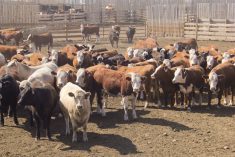Chicago | Reuters — Chicago Mercantile Exchange live cattle futures closed stronger and touched their highest prices in more than two weeks on Monday as livestock markets recovered from recent losses, analysts said.
The Dow and S+P 500 also ended higher, after turmoil in the banking sector recently weighed on equity and commodity markets. Cattle futures, in particular, can be affected by swings in equities because weakness in the economy can reduce consumers’ demand for pricey beef.
“We just got to a point where there ended up being some sizable short-covering today and maybe some new buying,” said Mike Sands, a livestock market analyst and president of MBS Research.
Read Also

U.S. livestock: Feeder cattle hit contract highs on tight supply
Chicago | Reuters – All Chicago Mercantile Exchange feeder cattle futures and most live cattle futures hit contract highs on…
CME April live cattle settled up 1.9 cents at 164.9 cents/lb., and June cattle finished 2.275 cents higher at 158.875 cents (all figures US$). Both contracts touched their highest prices since March 10.
CME April feeder cattle ended up 2.825 cents at 197.625 cents/lb. and reached their highest price since March 10. May feeders climbed 3.825 cents to finish at 201.375 cents and reached a March 14 high.
“We’ve seen some pretty massive liquidation in virtually all commodities over the course of the last two weeks or so,” Sands said. “Obviously, the cattle and feeder cattle and hogs have participated in that pretty sizable purge.”
Lean hog futures topped one-week highs at the CME after setting life-of-contract lows on Thursday.
Front-month April hogs ended up 1.45 cents at 78.625 cents/lb. June hogs finished 1.65 cents higher at 93.075 cents/lb.
Traders are waiting for the U.S. Department of Agriculture to issue a quarterly Hogs and Pigs report this week. Analysts surveyed by Reuters estimate the U.S. hog herd on March 1 was 0.2 per cent bigger than a year earlier.
In other news, Japan removed restrictions on Canadian beef imports that date back 20 years, Canada’s agriculture ministry said.
— Tom Polansek reports on agriculture and ag commodities for Reuters from Chicago.
















